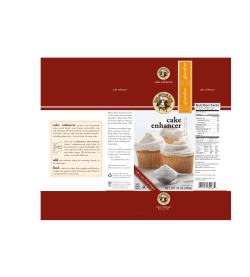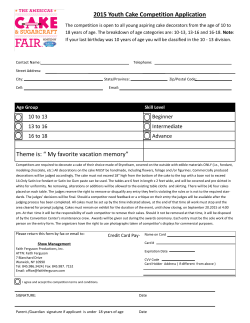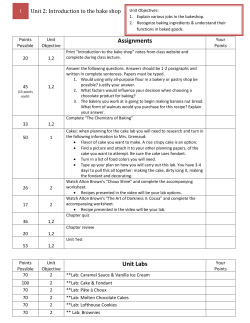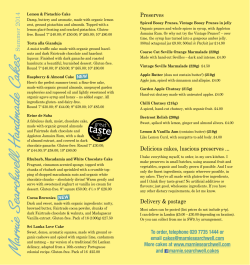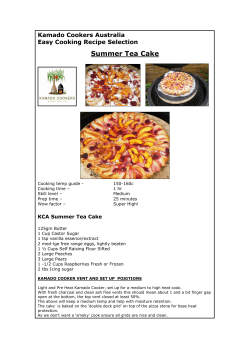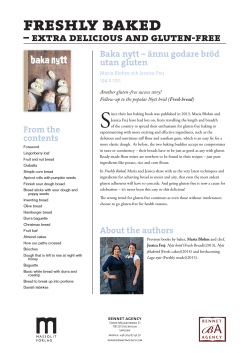
Impact of Tragacanth and Xanthan Gums on the Physical and
Nutrition and Food Sciences Research Vol 2, No 2, Apr-Jun 2015, pages: 29-37 Original Article Impact of Tragacanth and Xanthan Gums on the Physical and Textural Characteristics of Gluten-free Cake Mahsa Hojjatoleslami1, Mohammad-Hossain Azizi*2 1- M.Sc, Department of Food Science and Technology, Faculty of Agriculture, Shahr-e-Qods Branch, Islamic Azad University, Tehran, Iran 2- Department of Food Science and Technology, Faculty of Agriculture, Tarbiat Modares University, Tehran, Iran Received: January 2015 Accepted: March 2015 ABSTRACT Background and Objectives: The quality of cakes made of wheat flour depends on the quantity and quality of its gluten proteins; however, these proteins may have side effects for some people, including the patients with celiac, and the only way to cure this disease is to take a lifelong gluten-free diet. Materials and Methods: This research aims to produce gluten- free cake by using rice flour and xanthan and tragacanth gums, including two treatments of xanthan gum (0.5 &1 %), two treatments of tragacanth gum (0.5 & 1%), four combination treatments of xanthan gum and tragacanth, and one control treatment (without gum). The effects of tragacanth and xanthan gums on the texture characteristics, moisture content, water activity (aw), color, volume, apparent density, and porosity of the resulting cake were investigated. The data obtained were analyzed by the use of factorial experiments with three replications (3*3) and a Completely Randomized Design (CRD). Results: The results showed that the treatments containing gum have less texture stiffness compared to the control. Among the treatments, those having the combination of 0.5% tragacanth and 1% xanthan gum hold the maximum content of moisture. The L component amount of color of gluten-free cake samples was increased compared to the control while the rate of a and b components of color was decreased. The maximum amount of aw is related to the 0.5% treatment tragacanth and 1% xanthan, and the lowest aw belongs to the control. Apparent and bulk density has a difference with the control, and the minimum amount and the maximum amount belong to the treatment containing 1% tragacanth and the control, respectively. Conclusions: Samples containing 1% xanthan and 0.5% tragacanth could be desirable due to less texture stiffness, maximum content of moisture and aw, high color score, minimum density, and better keeping quality during the storage period. Keywords: Gluten-free cake, Tragacanth, Xanthan, Cake texture, Celiac Introduction Cake is a kind of sweet with a smooth and specific texture that is classified in the category of cooked foods, and its main components are flour, oil, sugar and egg. The product should have a porous texture, and tiny thin-walled and spongy cavity. Although porosity can be created by carbon dioxide, and the additives that release carbonic acid, as well as by air circulation via heating oil, sugar and egg, the spongy state is achieved by the gluten network formed in the cake. Gluten is the main compound responsible for determining the quality of gluten cakes, and is abundant in wheat, barley, rye and oats; however, it causes side effects to patients with celiac (1). Celiac is a digestive disease; a lifelong intestinal disorder, which is caused and developed in individuals sensitive to gluten. It is one of the most common genetic disorders in the world. Celiac is a silent disease; in most cases, it remains undiagnosed. *Address for correspondence: Mohammad-Hossain Azizi, Associate Prof, Department of Food Science and Technology, Faculty of Agriculture, Tarbiat Modares University, Tehran, Iran. E-mail address: azizit_m@modares.ac.ir Mahsa Hojjatoleslami and Mohammad-Hossain Azizi: Impact of gums on gluten-free cake Usually the disease occurs in adulthood (2). Celiac disease damages the small intestine villi, impairs absorption of nutrients such as iron, calcium and fatsoluble vitamins, and sometimes, causes weight loss, diarrhea, anemia, fatigue and bloating. It is also the cause of thyroid disease, cancer, skeletal diseases and infertility, as well as neurological and psychiatric problems (3). In female celiac patients with normal diet, menstruation delays, and menopause occurs earlier. Celiac disease can also cause infertility in both women and men. Abortion is one of the complications of the disease with normal diet (4). People suffering from celiac disease cannot tolerate gluten protein found in wheat, barley and rye. Hence, they encounter difficulties when consuming foods like cakes, bread, pasta, and alike. This condition can be reversed back to primal state by removing these materials out of the diet (3). So for production of gluten-free foods suitable for these patients, we can use starch products (corn, potatoes and rice), flour of cereals such as millet (5), sorghum (6), cassava, amaranth, buckwheat and quinine, which are glutenfree (7), and enzymes (lipoxygenase and transglutaminase), protein products like milk, soybean (8) and egg (9 more importantly hydrocolloids are used in order to mimic the properties of gluten. Adding hydrocolloids as linking agents with the ability to replace the gluten in bread derived from corn starch has been studied. Also the effects of technological gums like xanthan, guar, locust and tragacanth on the volume of the resulting breads have been evaluated. It has been reported that resins can effectively substitute for gluten in gluten-free systems, as they cause a dramatic increase in the size and crispy texture of bread. Xanthan gum established the highest quality in the bread (10). Onyango and colleagues (2010) reported production of bread without gluten based on corn starch, potato, cassava and rice. Their results showed that increasing the amount of starch in the formulation added to the adhesion and elasticity of dough, and lessened the firmness and smashing of the bread’s crumb and crust eventually, it was determined that the samples containing a mixture of rice starch, cassava starch and sorghum were more acceptable than other samples (11). Ronda and colleagues (2011) studied the effect of rice flour, corn, potato, wheat starch, and soybean ٣٠ Nutrition and Food Sciences Research protein isolated at zero, 10 and 20 % levels on the properties of gluten-free cake dough. The highest elastic state belonged to the rice flour dough and the 10% isolated soy protein samples with similar rheological properties of wheat flour dough, and was comparable in quality and quantity with the controls (12). Sciarini and colleagues (2012) investigated the effect of gums (xanthan, carboxy methyl cellulose, alginate and carrageenan), emulsifiers (diacetyl tartaric acid ester of mono glyceride and sodium stearoyl lactylate), glucose oxidase, and α-amylase enzymes on one of the gluten-free products containing rice flour, soy flour and cassava starch. The results showed that the use of these additives could improve the volume, and reduce the stiffness of the final product, compared with the control sample (13). Gularte and colleagues (2012) surveyed replacing 20% of rice flour with oat bran in glutenfree cake, and found that the use of oat bran increased the volume and rigidity, and improved color, crust and porosity of the final product (14). Accordingly and due to lack of enough gluten-free products in the market, the aim of this study is to investigate the impact of tragacanth and xanthan gums on the physical and textural characteristics of gluten-free cake, and present an appropriate formulation to produce gluten-free cake with similar quality of wheat flour cakes. Materials and Methods Ingredients: Rice flour and sugar were prepared from Tarkhineh factory (Iran) and Pardis sugar factory (Iran), respectively. Invert syrup is the product of Pope Decker (Turkey) and purchased from their representative in Iran. The Iranian brand Famila oil was bought from the market. Full egg was bought from Simorgh Company (Iran), tragacanth was obtained from Golpaygan city (Iran), and xanthan is the product of Sigma company (Germany), and purchased from its representative in Iran. The commercial brand of baking powder was Star produced by an Iranian company (Fel) and provided from the market. Vanilla was purchased from an Iranian trade mark (Bahman). Formulation of gluten-free cake: Cake dough consisted of 100g rice, 25g sugar, 25g oil, 36g eggs, 12g invert syrup, 2g baking powder, 0.2g vanilla, and sufficient volume of water for control. Other samples 30 Vol 2, No 2, Apr-Jun 2015 Mahsa Hojjatoleslami and Mohammad-Hossain Azizi: Impact of gums on gluten-free cake were: two treatments of xanthan gum (0.5 &1 %), two treatments of tragacanth gum (0.5 & 1%) and four combination treatments of xanthan gum and tragacanth gum (0/5% Xanthan and 0.5% Tragacanth, 1% Xanthan and 0.5% Tragacanth, 0/5% Xanthan and 1% Tragacanth, 1% Xanthan and 1% Tragacanth) based on 100g of rice flour. The production method of gluten-free cakes: At first, in order to prepare the cake dough, oil, sugar and eggs were mixed with an electric mixer (Black & Decker model M240, China) with the speed of 2 (2300 RPM) for 6 minutes to make a cream containing air bubbles. Then invert syrup and water were added to the cream, and stirring continued for 4 minutes. Afterwards, baking powder and vanilla were added to the rice flour, and the obtained mixture was gradually added to the cream. Then according to each of the two surface treatments, tragacanth gum at two levels (0.5 and 1%), xanthan gum at two levels (0.5 and 1%) and combination of the above gums based on the weight of rice flour were added to the mixture. Finally, by using a funnel pitcher, 75 g of the prepared dough was poured into special cake papercups. Then baking in the oven was done with hot air at 180 °C for 40 minutes. After cooling, the samples were stored at ambient temperature in polyethylene bags to evaluate their quantitative and qualitative characteristics. Evaluation of cake texture: The effect of different percentages of gum on the firmness and texture of cake in the first and seventh days after baking was measured. For this purpose, the universal testing machine (model 50KN-SUTM-Hounsfield, England) was used, and rigidity was considered as the maximum resistance against the deformation rate of 40% compression in the texture). To do this, a cubic piece with dimensions of 5 cm was isolated from the cake texture, and 1 cm (40%) of it was compressed by the machine probe (250 mm/min). The compressive forces exerted on the sample were reported in Newton (N). Measuring moisture: The moisture content of the cake was measured by a moisture meter (Sartorius, Germany) at 110 °C in the first and seventh days. Evaluating the color of cakes: For chromaticity of the cakes, their texture was studied by an American colorimetric system (model Hunter lab Color Flex), Vol 2, No 2, Apr-Jun 2015 and the factors L, a and b were measured and reported L means the brightness and varies from 0 to 100. The closer the obtained value is to 100 shows the brightness of the product. Conversely, the a number means green and red, which changes from -100 (the peak of greenness) to +100 (the peak of redness). The b number also varies from -100 (the peak of the blue color) to +100 (the peak of yellowness). Measurement of water activity (aw): The amount of aw was measured by using Aw Sprint Novasina (Switzerland) at 25 °C in the first day of production. Measurement of the volume: Volume was measured by using the method of displacement of rapeseed (15). A box with fixed dimensions (23.00 x 14.30 x 17.00 cm) and internal volume (5591.30 cm3 ) was put in a tray, half filled with seeds, shaken vigorously 4 times, and then filled till slightly overfilled. The box was shaken again twice, and then a straight edge was used to press across the top of the box once to give a level surface. The seeds were decanted from the box into a receptacle, and weighed. The procedure was repeated three times, and the mean value of the seed weight was recorded (C g). A weighed loaf was placed in the box, and the weighed seeds (3500 g) were used to fill the box, and leveled off as before. The overspill was weighed, and from the weight obtained the weight of seeds around the loaf and the volume of seeds displaced by the loaf were calculated using the following equations: Seeds displaced by loaf (L) = C g + overspill weight – 3500 g. Volume of bread (V) = L x 5591.30cm3/C. Apparent density measurement: Apparent density was obtained by measuring the ratio of the weight to the volume of the cake (16). Bulk density measurements (mass): Using piknometry (16), the ratio of the total weight of 10 cakes to the volume of the same amount of cakes was measured. Measured porosity: Porosity was calculated with the following equation (16): Porosity= 1- (Apparent density/bulk density) Statistical analysis: The data obtained from chemical analysis, rheology, texture and colorimetric measurements to compare the average were analyzed by the use of factorial experiments with three replications (3*3) and a Completely Randomized 31 Nutrition and Food Sciences Research Mahsa Hojjatoleslami and Mohammad-Hossain Azizi: Impact of gums on gluten-free cake Design (CRD). One-way ANOVA was used to compare means (DV) in different treatments and if ANOVA was significant followed by LSD post-hoctest. All statistical analyses were done by the SPSS software. The significance level was considered 0.05. The Excel software was also used for drawing the graphs. significantly more moisture content (at 5% level) compared to the control. Among the treatments, those having the combination of 0.5% tragacanth and 1% xanthan gum hold the maximum content of moisture due to high water-holding capacity of hydrocolloids (20). Results Table 2. Effect of different concentrations of xanthan and tragacanth gums on the moisture content of the cakes during different days of storage The effect of adding xanthan and tragacanth on the firmness of gluten-free cakes: According to Table 1, in the first and seventh days, the treatments containing gum have less texture stiffness compared to the control; this difference is significant at a confidence level of 95%. Statistically, increase in the firmness of the seventh day sample was significant comparing to that of the first day sample. Treatments Table 1. Effect of different concentrations of xanthan and tragacanth gums on the firmness characteristics of the cake during different days of storage Treatments First day Seventh day Control 57.73a ±3.6 108.43a ±6.8 0.5% Tragacanth 31.41d ±1.1 68.96d ±3.7 d 29.30 ±1.7 58.37d ±8.8 0.5% Xanthan d 30.02 ±1.8 70.66cd ±7.2 1% Xanthan 37.64bc ±2.3 70.40cd ±5.5 0/5% Xanthan and 0.5% Tragacanth b 41.15 ±1.6 92.46ab ±3.7 1% Xanthan and 0.5% Tragacanth 34.18cd ±1.6 86.93bc ±5.6 cd 34.50 ±1.7 89.73b ±5.9 d 89.80b ±4.5 1% Tragacanth 0/5% Xanthan and 1% Tragacanth 1% Xanthan and 1% Tragacanth 34.13 ±2.1 Seventh day First day Control f 21.85 ±0.09 21.87d ±0.15 0.5% Tragacanth 21.81f ±0.07 21.59d ±0.05 1% Tragacanth 22.63e ±0.12 21.43d ±0.20 0.5% Xanthan de 23.07 ±0.44 20.71e ±0.27 1% Xanthan 24.21bc ±0.27 22.81bc ±0.11 0/5% Xanthan and 0.5% Tragacanth cd 23.61 ±0.11 21.35de ±0.24 1% Xanthan and 0.5% Tragacanth 26.51a ±0.29 24.50a ±0.21 0/5% Xanthan and 1% Tragacanth 24.43b ±0.33 23.50b ±0.29 a 22.60c ±0.40 1% Xanthan and 1% Tragacanth 26.08 ±0.06 a,b,c ,d Mean values within a column with unlike superscript letters were significantly different (P<0•05) The effect of adding xanthan and tragacanth on the color components of gluten-free cakes: The L component amount of gluten-free cake samples was significantly increased compared to the control (at the confidence level of 95%) while the rate of a and b components was significantly decreased (at a confidence level of 95%). Among the available treatments, according to Table 3, the treatment containing 0.5% xanthan and 0.5% tragacanth has the highest L value, and the control treatment has the lowest L value. a,b,c ,d Mean values within a column with unlike superscript letters were significantly different (P<0•05) The effect of adding xanthan and tragacanth on the moisture content of gluten-free cakes: As shown in Table 2, the treatments containing combination of xanthan and tragacanth gums have Table 3. The interactive effect of tragacanth and xanthan gums on amount of the color components of gluten-free cakes Treatments Control 0.5% Tragacanth 1% Tragacanth 0.5% Xanthan 1% Xanthan 0/5% Xanthan and 0.5% Tragacanth 1% Xanthan and 0.5% Tragacanth 0/5% Xanthan and 1% Tragacanth 1% Xanthan and 1% Tragacanth L a 73.837b ±0.8100 77.113a ±1.1317 76.040a ±1.0508 77.060a ±0.8154 77.267a ±0.3036 77.147a ±0.2067 75.550ab ±0.6951 76.367a ±0.9417 76.813a ±0.1486 7.400a ±0.0608 6.203c ±0.0058 5.650e ±0.026 6.203c ±0.0058 6.100d ±0.0145 6.880b ±0.0115 5.450f ±0.0115 6.050d ±0.0058 6.080d ±0.0058 b 35.213a ±0.0296 31.213f ±0.0088 30.473h ±0.0176 31.213f ±0.012 32.120c ±0.115 31.60e ±0.0058 31.873d ±0.0088 32.950b ±0.0058 30.860g ±0.0058 a,b,c ,d Mean values within a column with unlike superscript letters were significantly different (P<0•05) ٣٢ Nutrition and Food Sciences Research 32 Vol 2, No 2, Apr-Jun 2015 Mahsa Hojjatoleslami and Mohammad-Hossain Azizi: Impact of gums on gluten-free cake The effect of adding xanthan and tragacanth on the apparent density of gluten-free cakes: According to Figure 2, apparent density in all treatments has a significant difference (at the 5% level) compared with the control treatment, and has the minimum amount of 0.3 and the maximum amount of 0.4 in the treatments containing 0.5% tragacanth, 1% xanthan (seventh treatment), respectively. The effect of adding xanthan and tragacanth on the water activity (aw) of gluten-free cakes: According to Figure 1, the maximum amount of aw is related to the treatment containing 0.5% tragacanth and 1% xanthan, and the lowest aw belongs to the control treatment. Figure 1. The interactive effect of adding xanthan and tragacanth on the water activity of gluten-free cake in the first day of baking. (Similar letters in each form or shape in the level of P <0.05 were not significantly different). Figure 2. The interactive effect of adding xanthan and tragacanth on the apparent density of gluten-free cake in the first day of baking. (Similar letters in each form or shape in the level of P <0.05 were not significantly different). Vol 2, No 2, Apr-Jun 2015 33 Nutrition and Food Sciences Research Mahsa Hojjatoleslami and Mohammad-Hossain Azizi: Impact of gums on gluten-free cake bulk density (0.40) belong to the treatments containing 1% tragacanth and the control, respectively. Figure 4 shows that the maximum porosity belongs to the treatments containing 1% xanthan and 1% tragacanth, respectively; the difference is statistically significant. The effect of adding xanthan and tragacanth on the bulk density and porosity of gluten-free cakes: As shown in Figure 3, in all treatments, the bulk density has a significant difference (at the 5% level) compared with the control treatment, and the minimum amount (0.30) and the maximum amount of Figure 3. The interactive effect of adding xanthan and tragacanth on the bulk density of gluten-free cake in the first day of baking. (Similar letters in each form or shape in the level of P <0.05 were not significantly different). Figure 4. The interactive effect of adding xanthan and tragacanth on the porosity rate of gluten-free cake in the first day of baking. (Similar letters in each form or shape in the level of P <0.05 were not significantly different). ٣٤ Nutrition and Food Sciences Research 34 Vol 2, No 2, Apr-Jun 2015 Mahsa Hojjatoleslami and Mohammad-Hossain Azizi: Impact of gums on gluten-free cake the addition of gum to gluten-free bread containing rice flour and corn starch, made its color brighter (22). The increase of L component is due to high water storage capacity of the gums (23). These additives reduce the surface of the finished product to retain moisture and prevent the outflow of water during the cooking, which, in turn, can be effective in increasing this color component. Purlis and Salvadori (2009) stated that changes in the baking industry products are responsible for their brightness, and that the orderly and smooth surfaces compared to frizzy surfaces are more capable of reflecting light and increasing the L component (24). The effect of adding xanthan and tragacanth on the water activity (aw) of gluten-free cakes: Water activity (aw) is an appropriate factor for assessing the microbiological stability and durability of the food products (25). Lower aw leads to increased endurance and delay in molding of the cooked cakes with these formulations (Figure 1). The effect of adding xanthan and tragacanth on the apparent density of gluten-free cakes: According to Figure 2, maximum amount of apparent density belongs to treatments containing 0.5% tragacanth, 1% xanthan, the reason is creating more viscous tragacanth and xanthan, and trapping more gas bubbles generated in the cake, which results in a further volume increase of the cake. These results are similar to the findings of Shokri Busjin et al. (2004), and Sowmya and colleagues (2009) (26, 27). Due to the inverse relationship between volume and apparent density, creating a lower apparent density in highervolume cakes and creating more apparent density in smaller-volume cakes seem natural. Arozarena and colleagues (2001) investigated the effect of xanthan gum on cake volume. Also Sciarini et al. (2012) and Demirkesen et al. (2010) demonstrated that using gum paste was effective in increasing the volume of gluten-free products, and extend their specific volume from 1.64 ml/g to more than 2 ml/g (1, 13, 28). The effect of adding xanthan and tragacanth on the bulk density and porosity of gluten-free cakes: As shown in Figure 3 and Figure 4, maximum amount of bulk density and porosity belong to the treatments containing 1% tragacanth and 1% xanthan, respectively. Due to having more volume of the cake samples prepared with different percentages of Discussion The effect of adding xanthan and tragacanth on the firmness of gluten-free cakes: Gambus et al. (2007) achieved the maximum firmness of bread crumb at a time when the minimum xanthan was added to the floury mix (potato starch and corn starch), and by increasing the amount of xanthan, the firmness of bread was also decreased (5). Mezaize et al. (2005) found similar results when xanthan gum and guar flour mixture consisting of rice flour, corn starch, corn flour, and potato starch were added. They reported that the addition of hydrocolloids to formulations caused to produce gluten-free bread with softer crumb (3). The effectiveness of tragacanth on the soft texture is due to moisture preservation in the cake texture and prevention of the moisture to emigrate to the string of starch to crystallize them (15). Overall, in all samples during the preservation period to seven days, the hardness of texture was increased, which is indicative of staling during the storage period. Gambus et al. (2005), Moore et al. (2006) and Onyango et al. (2005) found similar results (5, 18, and 19). It seems that the main reason of staling in gluten-free products is reduced moisture and thus its easy emigration from the crumb to the crust in the absence of gluten (Table 1). The effect of adding xanthan and tragacanth on the moisture content of gluten-free cakes: The cause of high moisture content of the treatment samples relative to the control is the high power of xanthan and tragacanth to absorb and retain water during the cooking and storage processes (Table 2). Ayoubi et al. (2011), investigating the effect of xanthan and guar gums on the moisture content of oil cake, found that these two gums at the confidence level of 95% were able to increase the rate of this parameter in comparison with the gum-free sample (21). Average moisture content in the seventh day relative to the first day was decreased significantly. The decreased moisture content on the seventh day represents the moisture exit and thus the cakes’ staling during the storage period. The effect of adding xanthan and tragacanth on the color components of gluten-free cakes: The illuminating effect of color by xanthan and tragacanth could be related to their role in distribution of water (Table 3). Lazaridou and colleagues (2007) found that Vol 2, No 2, Apr-Jun 2015 35 Nutrition and Food Sciences Research Mahsa Hojjatoleslami and Mohammad-Hossain Azizi: Impact of gums on gluten-free cake 8. Curic D, Gabric D, Bauman I, Tusak D, Novotni D. Gluten free bread production by the corn meal and soybean flour extruded blend usage. Agr Conspe Sci 2007; 72(3): 227-232. xanthan and tragacanth, higher porosity in these samples compared to the control seems logical. The increase in porosity amount is due to increase in the size and number of gas cells/bubbles and their uniform distribution in the product’s texture (29). In this study, the effect of xanthan and tragacanth gums on the texture characteristics, moisture content, aw, apparent and bulk density, specific volume, porosity, color components of the crust, sensory characteristics, and staling of the cakes was investigated. The results showed that xanthan and tragacanth gum treatments, especially in combination form, in addition to increasing the amount of moisture, are capable of improving the especial volume, porosity, color component and sensory properties, and reducing the texture firmness in the interval between the first day and seventh day after baking. The best result in the sensory analysis was obtained in the sample containing 1%xanthan and 5%tragacanth; due to high quantitative and qualitative properties, this treatment could be desirable and acceptable for patients with celiac, and even normal people. 9. Ribotta PD, Ausar SF, Morcillo MH, Perez GT, Beltramo DM, Leon AE. Production of gluten free bread using soybean flour. J Sci Food Agr 2004; 84: 1969-1974. 10. Anton A, Artfield S. Hydrocolloids in gluten-free breads: A review. Int J Food Sci Nutr 2008; 59(1):1123. 11. Onyango C, Mutungi C, Unbehend G, Lindhauer MG. Modification of gluten – free sorghum batter and bread using maize, potato, cassava or rice starch. Food Sci Technol 2010; 1-6. 12. Ronda F, Oliete B, Gomez M, Caballero P, Pando V. Rheological study of layer cake batters made with soybean protein isolate and different starch sources. J Food Eng 2011;112: 272-277. 13. Sciarini LS, Ribotta PD, Leon AE, Perez GT. Incorporation of several additives into gluten free bread: Effect on dough properties and bread quality. J Food Eng 2012; 111(4): 590- 579. 14. Gularte MA, Hera E, Gomez, Rosell M. Effect of different fibers on batter and gluten free layer cake properties. LWT- Food Sci Technol 2012; 48(2): 209214. Financial disclosure 15. Lin Sh.D, Lee CC. Qualities of Chiffon Cake Prepared with Indigestible Dextrin and Sucralose as Replacement for Sucrose. Cereal Chem 2005; 82 (4), 405–413. The authors declared no financial interest. Funding/Support The study did not receive any financial support. 16. Kocer D, Hicsasmaz Z, Bayindirli A, Katnas SA. Bubble and pore formation of the high-ratio cake formulation with polydextrose as a sugar- and fatreplacer. J Food Eng 2006; 78, 953-964. References 1. Demirkesen I, Mert B, Sumnu G, Sahin S. Rheological properties of gluten-free bread formulation. J Food Eng 2010; 96: 295-303. 17. Gomez M, Ronda F, Caballero PA, Blanco CA, Rosell CM. Functionality of different hydrocolloids on the quality and shelf-life of yellow layer cakes. Food Hydrocolloid 2007; 21,167-173 2. Fasano A, Catassi C. Current approaches to diagnosis and treatment of celiac disease: An evolving spectrum. Gastroenterology 2001; 120: 636-651. 18. Moore MM, Heinbockel M, Dockery P, Ulmer HM, Arendt EK. Network formation in gluten-free bread with application of transglutaminase. Cereal Chem 2006; 83, 28-36. 3. Mezaize S, Chevallier S, Le Bail A, De Lamballerif M. Optimization of gluten-free formulations for Frenchstyle breads. J Food Sci 2009; 74: 140-146. 19. Onyango C, Unbehend G, Lindhauer MG. Effect of cellulose-derivatives and emulsifiers on creep-recovery and crumb properties of gluten-free bread prepared from sorghum and gelatinized cassava starch. Food Res Int 2009; 42: 949–955. 4. Holmes GKT, Catassi C. Celiac Disease. Health Press. Oxford 2000. 5. Gambus H, Sikora M, Ziobro R. The effect of composition of hydrocolloids on properties of gluten free bread. Acta Scien Tiarum Polonorum 2007; 6(3): 61-74. 20. Rosell CM, Rojas JA, Barber DB. Influence of hydrocolloids on dough rheology and bread quality. Food Hydrocolloids 2001;15: 75-81. 6. Lopez ACB, Pereira AJG, Junqueira RG. Flour mixture of rice flour, corn and cassava starch in the production of gluten free white bread. Braz Arch Biol Technol 2004; 47: 63-70. 21. Ayoubi A, Habibi Nahafi M. B, Karimi M. Effect of different levels of whey protein concentrates on the physic-chemical and sensory properties of muffin cake. J Food Sci Technol Vol. 8, No. 29 2011 [in Persian]. 7. Elke KA, Dal Bello F. The gluten-free cereal products and beverages, Elsevier Inc 2008; pp. 1-394 . ٣٦ Nutrition and Food Sciences Research 36 Vol 2, No 2, Apr-Jun 2015 Mahsa Hojjatoleslami and Mohammad-Hossain Azizi: Impact of gums on gluten-free cake 22. Lazaridou A, Duta D, Papageorgiou M, Belc N and Biliaderis CG. Effects of hydrocolloids on dough rheology and bread quality parameters in gluten-free formulations. J Food Eng 2007; 79: 1033-1047. tragacanth gum and comparison with Arabic gum and its utilization in a cake. MSc Thesis. Isfahan: University of Technology, 2004 [in Persian]. 27. Sowmya M, Jeyarani T, Jyotsna R, Indrani D. Effect of replacement of fat with sesame oil and additives on rheological, microstructural, quality characteristics and fatty acid profile of cakes. Food Hyd 2009; 23, 1827– 1836. 23. Naghipour F, HabibiNajafi MB, Karimi M, Haddad Khodaparast MH, Sheikholeslami Z, Sahraiyan B. Application sorghum flour in free gluten cake production. National Conference of Iranian Agricultural Research Strategy. Islamic Azad University, Takestan Branch 2012 [in Persian]. 28. Arozarena I, Bertholo MM, Empise J, Bunger A, Sousa ID. Study of the total replacement of egg by white lupine protein, emulsifiers and xanthan gum in yellow cake. Eur Res Technol 2001; 213: 312-316. 24. Purlis E, Salvadori V. Modeling the browning of bread during baking. Food Res Int 2009; 42: 865-870. 25. Winkelhausen E, Jovanovic-Malinovska R, Velickova E, Kuzmanova S. Sensory and Microbiological quality of a baked product containing xylitol as an alternative sweetener. Int J Food Prop 2007; 10(3), 639-649. 29. Ziobro R, Korus J, Witczak M, and Juszczak L. Influence of modified starches on properties of gluten free dough and bread. Part II: Quality and staling of gluten free bread. Food Hydrocolloids 2012; 29(1):6874. 26. Shokri Busjin Z. Evaluation of relationship between structure, operational and rheological properties of Vol 2, No 2, Apr-Jun 2015 37 Nutrition and Food Sciences Research
© Copyright 2025
